Australian Accounting Trends & Issues
VerifiedAdded on 2020/05/28
|11
|3019
|77
AI Summary
This assignment analyzes current trends and issues within the Australian accounting landscape. It draws upon a collection of academic articles published in reputable journals like the Australian Accounting Review and Company and Securities Law Journal. The papers cover topics such as auditor reporting practices, going-concern opinions, ethical considerations, integrated reporting, and fraud risk assessment.
Contribute Materials
Your contribution can guide someone’s learning journey. Share your
documents today.
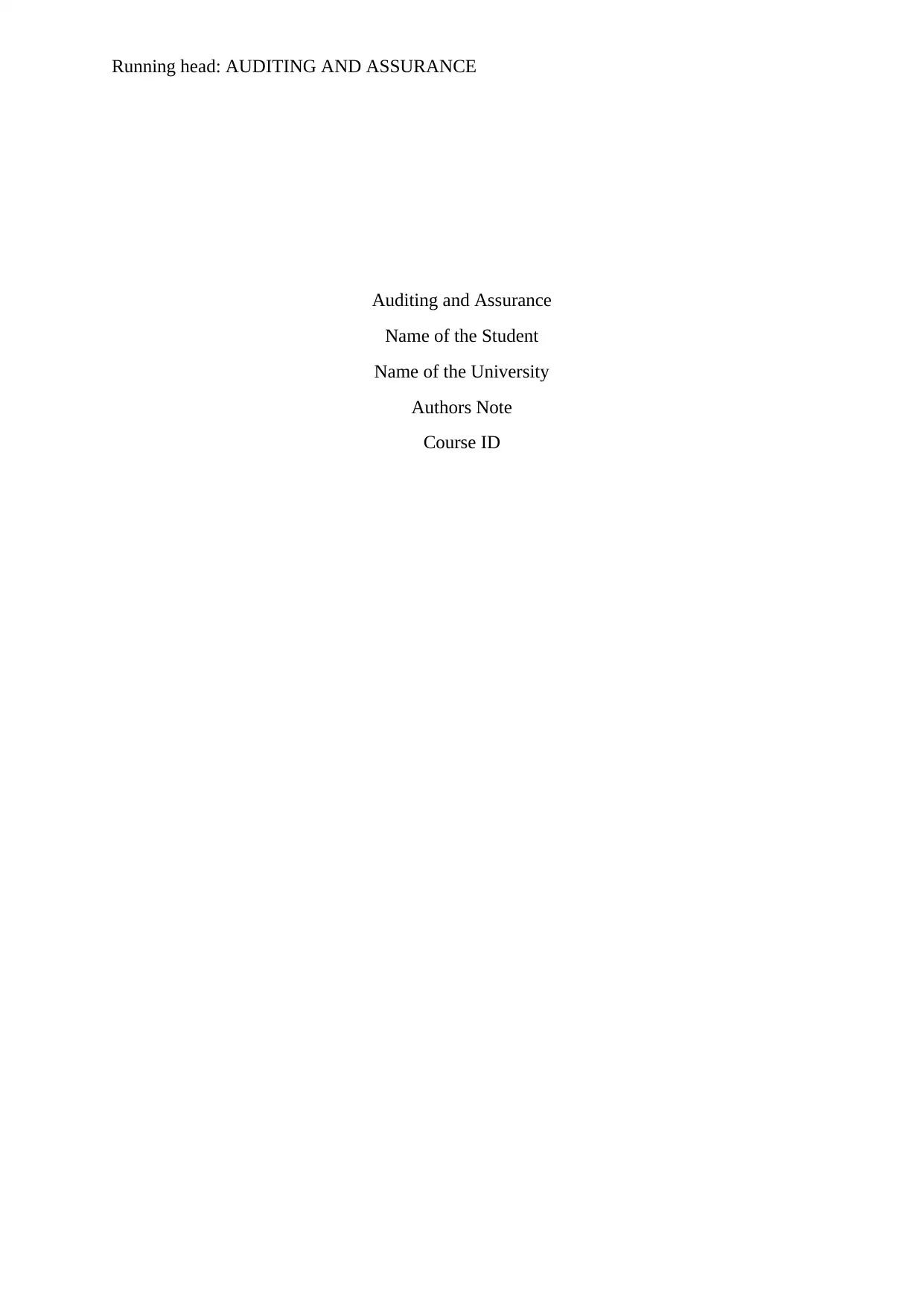
Running head: AUDITING AND ASSURANCE
Auditing and Assurance
Name of the Student
Name of the University
Authors Note
Course ID
Auditing and Assurance
Name of the Student
Name of the University
Authors Note
Course ID
Secure Best Marks with AI Grader
Need help grading? Try our AI Grader for instant feedback on your assignments.
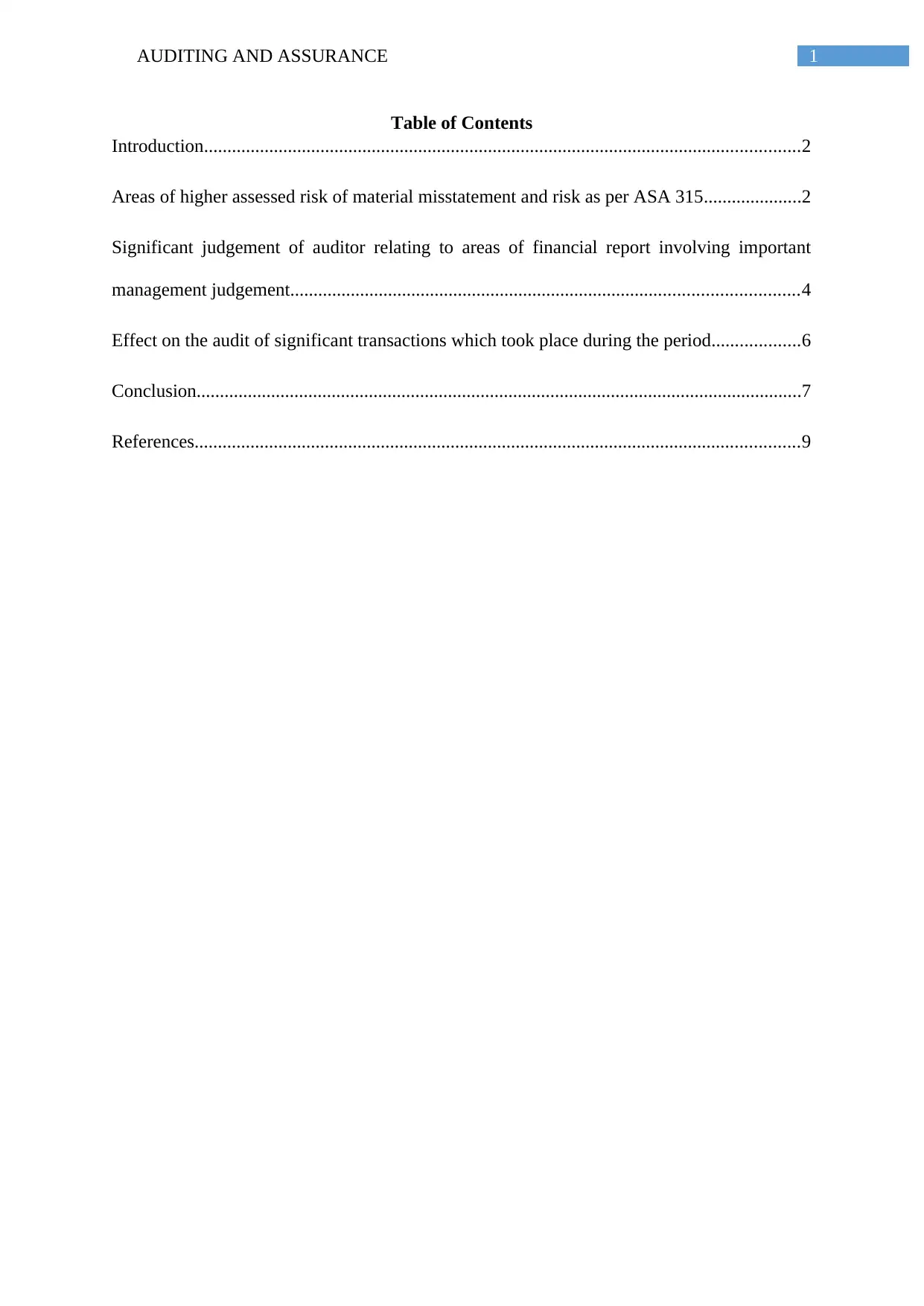
1AUDITING AND ASSURANCE
Table of Contents
Introduction................................................................................................................................2
Areas of higher assessed risk of material misstatement and risk as per ASA 315.....................2
Significant judgement of auditor relating to areas of financial report involving important
management judgement.............................................................................................................4
Effect on the audit of significant transactions which took place during the period...................6
Conclusion..................................................................................................................................7
References..................................................................................................................................9
Table of Contents
Introduction................................................................................................................................2
Areas of higher assessed risk of material misstatement and risk as per ASA 315.....................2
Significant judgement of auditor relating to areas of financial report involving important
management judgement.............................................................................................................4
Effect on the audit of significant transactions which took place during the period...................6
Conclusion..................................................................................................................................7
References..................................................................................................................................9
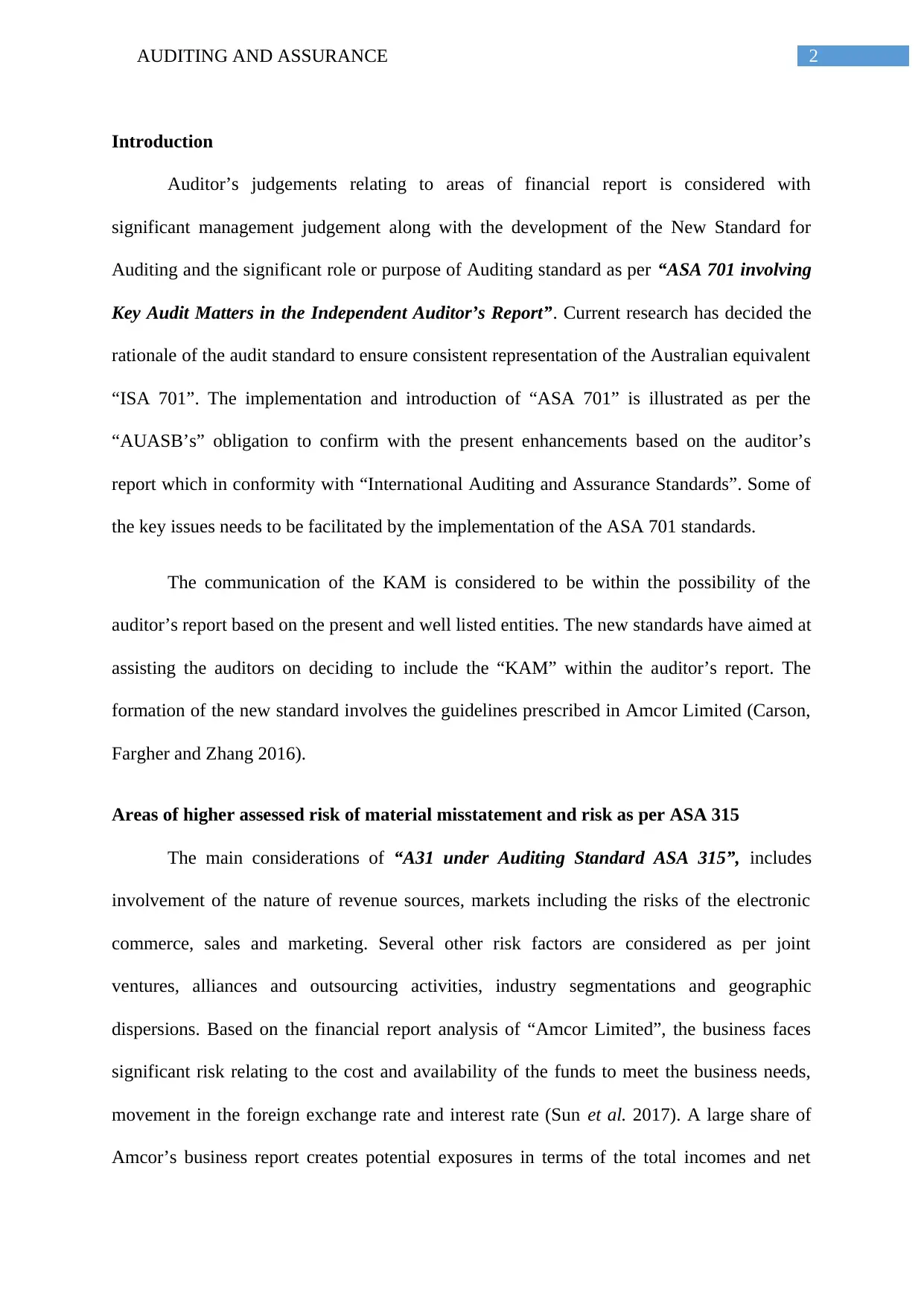
2AUDITING AND ASSURANCE
Introduction
Auditor’s judgements relating to areas of financial report is considered with
significant management judgement along with the development of the New Standard for
Auditing and the significant role or purpose of Auditing standard as per “ASA 701 involving
Key Audit Matters in the Independent Auditor’s Report”. Current research has decided the
rationale of the audit standard to ensure consistent representation of the Australian equivalent
“ISA 701”. The implementation and introduction of “ASA 701” is illustrated as per the
“AUASB’s” obligation to confirm with the present enhancements based on the auditor’s
report which in conformity with “International Auditing and Assurance Standards”. Some of
the key issues needs to be facilitated by the implementation of the ASA 701 standards.
The communication of the KAM is considered to be within the possibility of the
auditor’s report based on the present and well listed entities. The new standards have aimed at
assisting the auditors on deciding to include the “KAM” within the auditor’s report. The
formation of the new standard involves the guidelines prescribed in Amcor Limited (Carson,
Fargher and Zhang 2016).
Areas of higher assessed risk of material misstatement and risk as per ASA 315
The main considerations of “A31 under Auditing Standard ASA 315”, includes
involvement of the nature of revenue sources, markets including the risks of the electronic
commerce, sales and marketing. Several other risk factors are considered as per joint
ventures, alliances and outsourcing activities, industry segmentations and geographic
dispersions. Based on the financial report analysis of “Amcor Limited”, the business faces
significant risk relating to the cost and availability of the funds to meet the business needs,
movement in the foreign exchange rate and interest rate (Sun et al. 2017). A large share of
Amcor’s business report creates potential exposures in terms of the total incomes and net
Introduction
Auditor’s judgements relating to areas of financial report is considered with
significant management judgement along with the development of the New Standard for
Auditing and the significant role or purpose of Auditing standard as per “ASA 701 involving
Key Audit Matters in the Independent Auditor’s Report”. Current research has decided the
rationale of the audit standard to ensure consistent representation of the Australian equivalent
“ISA 701”. The implementation and introduction of “ASA 701” is illustrated as per the
“AUASB’s” obligation to confirm with the present enhancements based on the auditor’s
report which in conformity with “International Auditing and Assurance Standards”. Some of
the key issues needs to be facilitated by the implementation of the ASA 701 standards.
The communication of the KAM is considered to be within the possibility of the
auditor’s report based on the present and well listed entities. The new standards have aimed at
assisting the auditors on deciding to include the “KAM” within the auditor’s report. The
formation of the new standard involves the guidelines prescribed in Amcor Limited (Carson,
Fargher and Zhang 2016).
Areas of higher assessed risk of material misstatement and risk as per ASA 315
The main considerations of “A31 under Auditing Standard ASA 315”, includes
involvement of the nature of revenue sources, markets including the risks of the electronic
commerce, sales and marketing. Several other risk factors are considered as per joint
ventures, alliances and outsourcing activities, industry segmentations and geographic
dispersions. Based on the financial report analysis of “Amcor Limited”, the business faces
significant risk relating to the cost and availability of the funds to meet the business needs,
movement in the foreign exchange rate and interest rate (Sun et al. 2017). A large share of
Amcor’s business report creates potential exposures in terms of the total incomes and net
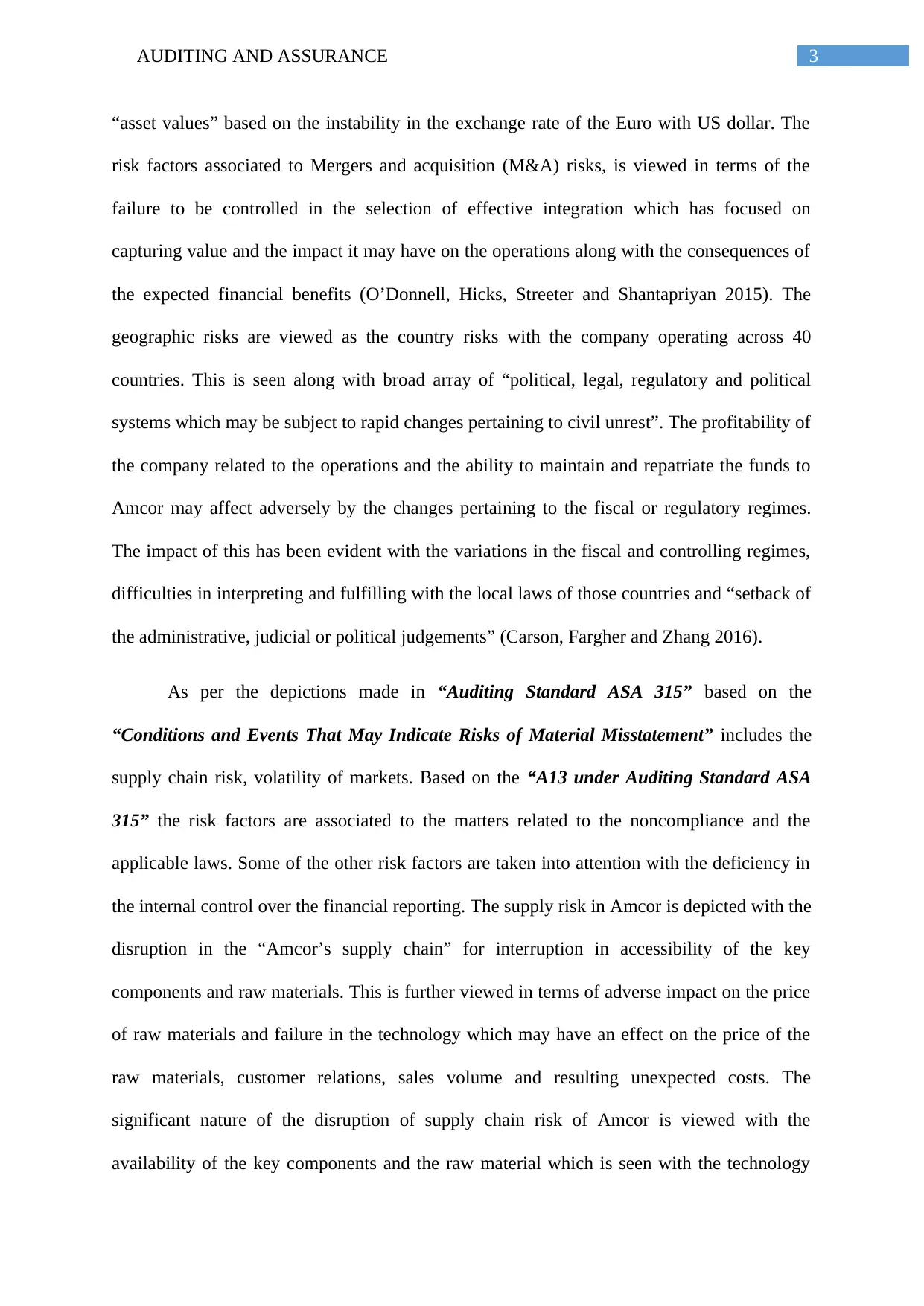
3AUDITING AND ASSURANCE
“asset values” based on the instability in the exchange rate of the Euro with US dollar. The
risk factors associated to Mergers and acquisition (M&A) risks, is viewed in terms of the
failure to be controlled in the selection of effective integration which has focused on
capturing value and the impact it may have on the operations along with the consequences of
the expected financial benefits (O’Donnell, Hicks, Streeter and Shantapriyan 2015). The
geographic risks are viewed as the country risks with the company operating across 40
countries. This is seen along with broad array of “political, legal, regulatory and political
systems which may be subject to rapid changes pertaining to civil unrest”. The profitability of
the company related to the operations and the ability to maintain and repatriate the funds to
Amcor may affect adversely by the changes pertaining to the fiscal or regulatory regimes.
The impact of this has been evident with the variations in the fiscal and controlling regimes,
difficulties in interpreting and fulfilling with the local laws of those countries and “setback of
the administrative, judicial or political judgements” (Carson, Fargher and Zhang 2016).
As per the depictions made in “Auditing Standard ASA 315” based on the
“Conditions and Events That May Indicate Risks of Material Misstatement” includes the
supply chain risk, volatility of markets. Based on the “A13 under Auditing Standard ASA
315” the risk factors are associated to the matters related to the noncompliance and the
applicable laws. Some of the other risk factors are taken into attention with the deficiency in
the internal control over the financial reporting. The supply risk in Amcor is depicted with the
disruption in the “Amcor’s supply chain” for interruption in accessibility of the key
components and raw materials. This is further viewed in terms of adverse impact on the price
of raw materials and failure in the technology which may have an effect on the price of the
raw materials, customer relations, sales volume and resulting unexpected costs. The
significant nature of the disruption of supply chain risk of Amcor is viewed with the
availability of the key components and the raw material which is seen with the technology
“asset values” based on the instability in the exchange rate of the Euro with US dollar. The
risk factors associated to Mergers and acquisition (M&A) risks, is viewed in terms of the
failure to be controlled in the selection of effective integration which has focused on
capturing value and the impact it may have on the operations along with the consequences of
the expected financial benefits (O’Donnell, Hicks, Streeter and Shantapriyan 2015). The
geographic risks are viewed as the country risks with the company operating across 40
countries. This is seen along with broad array of “political, legal, regulatory and political
systems which may be subject to rapid changes pertaining to civil unrest”. The profitability of
the company related to the operations and the ability to maintain and repatriate the funds to
Amcor may affect adversely by the changes pertaining to the fiscal or regulatory regimes.
The impact of this has been evident with the variations in the fiscal and controlling regimes,
difficulties in interpreting and fulfilling with the local laws of those countries and “setback of
the administrative, judicial or political judgements” (Carson, Fargher and Zhang 2016).
As per the depictions made in “Auditing Standard ASA 315” based on the
“Conditions and Events That May Indicate Risks of Material Misstatement” includes the
supply chain risk, volatility of markets. Based on the “A13 under Auditing Standard ASA
315” the risk factors are associated to the matters related to the noncompliance and the
applicable laws. Some of the other risk factors are taken into attention with the deficiency in
the internal control over the financial reporting. The supply risk in Amcor is depicted with the
disruption in the “Amcor’s supply chain” for interruption in accessibility of the key
components and raw materials. This is further viewed in terms of adverse impact on the price
of raw materials and failure in the technology which may have an effect on the price of the
raw materials, customer relations, sales volume and resulting unexpected costs. The
significant nature of the disruption of supply chain risk of Amcor is viewed with the
availability of the key components and the raw material which is seen with the technology
Secure Best Marks with AI Grader
Need help grading? Try our AI Grader for instant feedback on your assignments.
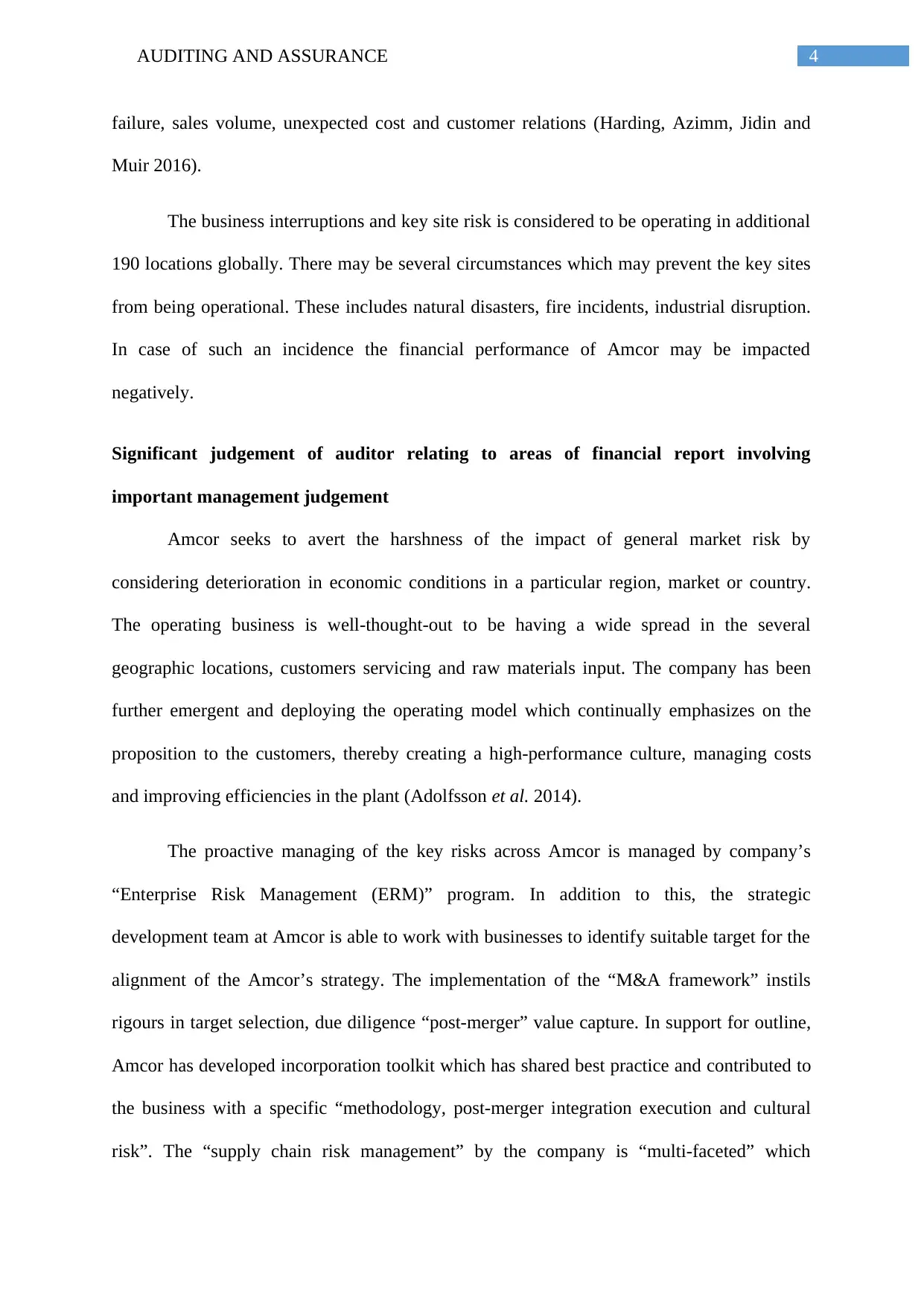
4AUDITING AND ASSURANCE
failure, sales volume, unexpected cost and customer relations (Harding, Azimm, Jidin and
Muir 2016).
The business interruptions and key site risk is considered to be operating in additional
190 locations globally. There may be several circumstances which may prevent the key sites
from being operational. These includes natural disasters, fire incidents, industrial disruption.
In case of such an incidence the financial performance of Amcor may be impacted
negatively.
Significant judgement of auditor relating to areas of financial report involving
important management judgement
Amcor seeks to avert the harshness of the impact of general market risk by
considering deterioration in economic conditions in a particular region, market or country.
The operating business is well-thought-out to be having a wide spread in the several
geographic locations, customers servicing and raw materials input. The company has been
further emergent and deploying the operating model which continually emphasizes on the
proposition to the customers, thereby creating a high-performance culture, managing costs
and improving efficiencies in the plant (Adolfsson et al. 2014).
The proactive managing of the key risks across Amcor is managed by company’s
“Enterprise Risk Management (ERM)” program. In addition to this, the strategic
development team at Amcor is able to work with businesses to identify suitable target for the
alignment of the Amcor’s strategy. The implementation of the “M&A framework” instils
rigours in target selection, due diligence “post-merger” value capture. In support for outline,
Amcor has developed incorporation toolkit which has shared best practice and contributed to
the business with a specific “methodology, post-merger integration execution and cultural
risk”. The “supply chain risk management” by the company is “multi-faceted” which
failure, sales volume, unexpected cost and customer relations (Harding, Azimm, Jidin and
Muir 2016).
The business interruptions and key site risk is considered to be operating in additional
190 locations globally. There may be several circumstances which may prevent the key sites
from being operational. These includes natural disasters, fire incidents, industrial disruption.
In case of such an incidence the financial performance of Amcor may be impacted
negatively.
Significant judgement of auditor relating to areas of financial report involving
important management judgement
Amcor seeks to avert the harshness of the impact of general market risk by
considering deterioration in economic conditions in a particular region, market or country.
The operating business is well-thought-out to be having a wide spread in the several
geographic locations, customers servicing and raw materials input. The company has been
further emergent and deploying the operating model which continually emphasizes on the
proposition to the customers, thereby creating a high-performance culture, managing costs
and improving efficiencies in the plant (Adolfsson et al. 2014).
The proactive managing of the key risks across Amcor is managed by company’s
“Enterprise Risk Management (ERM)” program. In addition to this, the strategic
development team at Amcor is able to work with businesses to identify suitable target for the
alignment of the Amcor’s strategy. The implementation of the “M&A framework” instils
rigours in target selection, due diligence “post-merger” value capture. In support for outline,
Amcor has developed incorporation toolkit which has shared best practice and contributed to
the business with a specific “methodology, post-merger integration execution and cultural
risk”. The “supply chain risk management” by the company is “multi-faceted” which
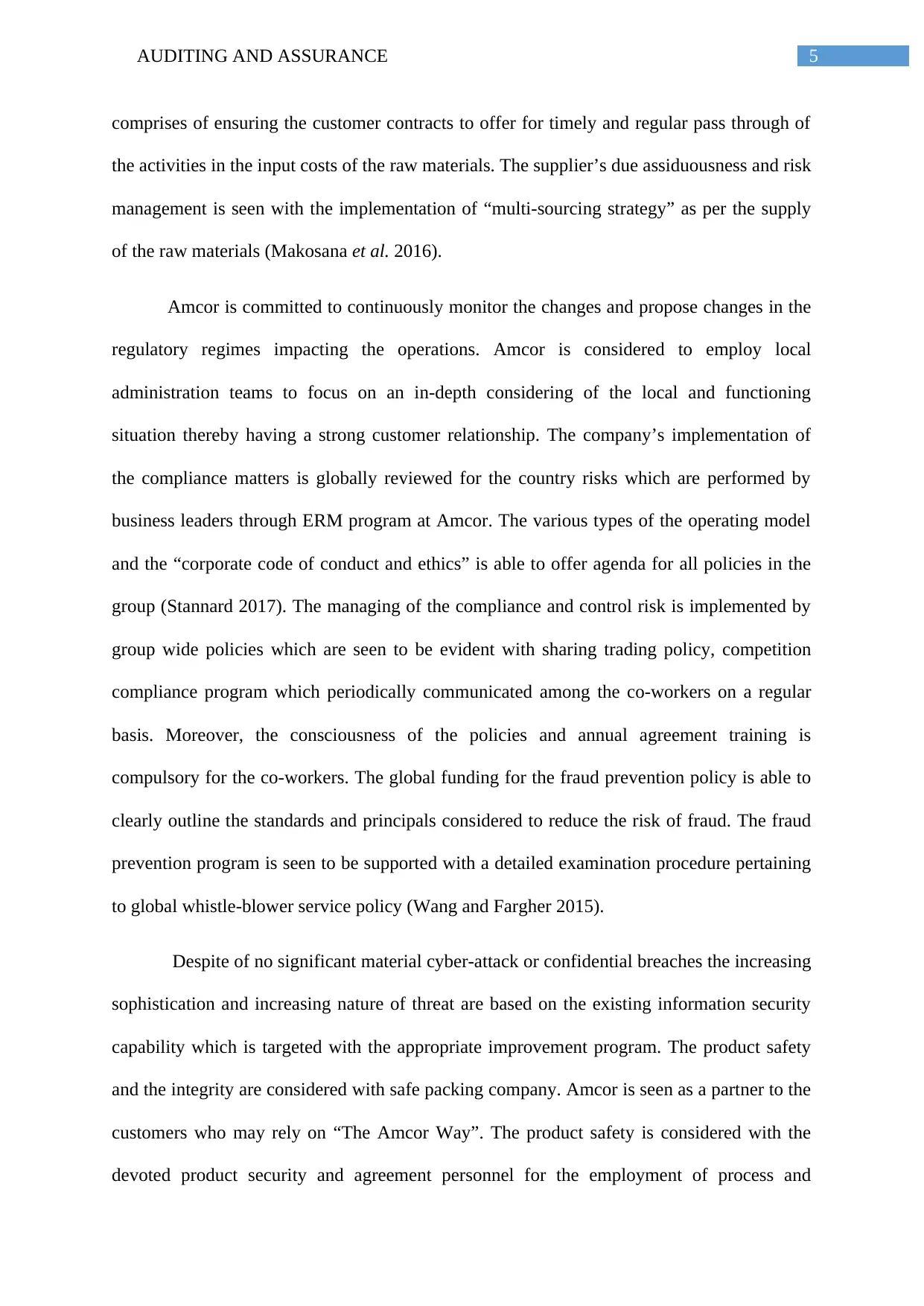
5AUDITING AND ASSURANCE
comprises of ensuring the customer contracts to offer for timely and regular pass through of
the activities in the input costs of the raw materials. The supplier’s due assiduousness and risk
management is seen with the implementation of “multi-sourcing strategy” as per the supply
of the raw materials (Makosana et al. 2016).
Amcor is committed to continuously monitor the changes and propose changes in the
regulatory regimes impacting the operations. Amcor is considered to employ local
administration teams to focus on an in-depth considering of the local and functioning
situation thereby having a strong customer relationship. The company’s implementation of
the compliance matters is globally reviewed for the country risks which are performed by
business leaders through ERM program at Amcor. The various types of the operating model
and the “corporate code of conduct and ethics” is able to offer agenda for all policies in the
group (Stannard 2017). The managing of the compliance and control risk is implemented by
group wide policies which are seen to be evident with sharing trading policy, competition
compliance program which periodically communicated among the co-workers on a regular
basis. Moreover, the consciousness of the policies and annual agreement training is
compulsory for the co-workers. The global funding for the fraud prevention policy is able to
clearly outline the standards and principals considered to reduce the risk of fraud. The fraud
prevention program is seen to be supported with a detailed examination procedure pertaining
to global whistle-blower service policy (Wang and Fargher 2015).
Despite of no significant material cyber-attack or confidential breaches the increasing
sophistication and increasing nature of threat are based on the existing information security
capability which is targeted with the appropriate improvement program. The product safety
and the integrity are considered with safe packing company. Amcor is seen as a partner to the
customers who may rely on “The Amcor Way”. The product safety is considered with the
devoted product security and agreement personnel for the employment of process and
comprises of ensuring the customer contracts to offer for timely and regular pass through of
the activities in the input costs of the raw materials. The supplier’s due assiduousness and risk
management is seen with the implementation of “multi-sourcing strategy” as per the supply
of the raw materials (Makosana et al. 2016).
Amcor is committed to continuously monitor the changes and propose changes in the
regulatory regimes impacting the operations. Amcor is considered to employ local
administration teams to focus on an in-depth considering of the local and functioning
situation thereby having a strong customer relationship. The company’s implementation of
the compliance matters is globally reviewed for the country risks which are performed by
business leaders through ERM program at Amcor. The various types of the operating model
and the “corporate code of conduct and ethics” is able to offer agenda for all policies in the
group (Stannard 2017). The managing of the compliance and control risk is implemented by
group wide policies which are seen to be evident with sharing trading policy, competition
compliance program which periodically communicated among the co-workers on a regular
basis. Moreover, the consciousness of the policies and annual agreement training is
compulsory for the co-workers. The global funding for the fraud prevention policy is able to
clearly outline the standards and principals considered to reduce the risk of fraud. The fraud
prevention program is seen to be supported with a detailed examination procedure pertaining
to global whistle-blower service policy (Wang and Fargher 2015).
Despite of no significant material cyber-attack or confidential breaches the increasing
sophistication and increasing nature of threat are based on the existing information security
capability which is targeted with the appropriate improvement program. The product safety
and the integrity are considered with safe packing company. Amcor is seen as a partner to the
customers who may rely on “The Amcor Way”. The product safety is considered with the
devoted product security and agreement personnel for the employment of process and
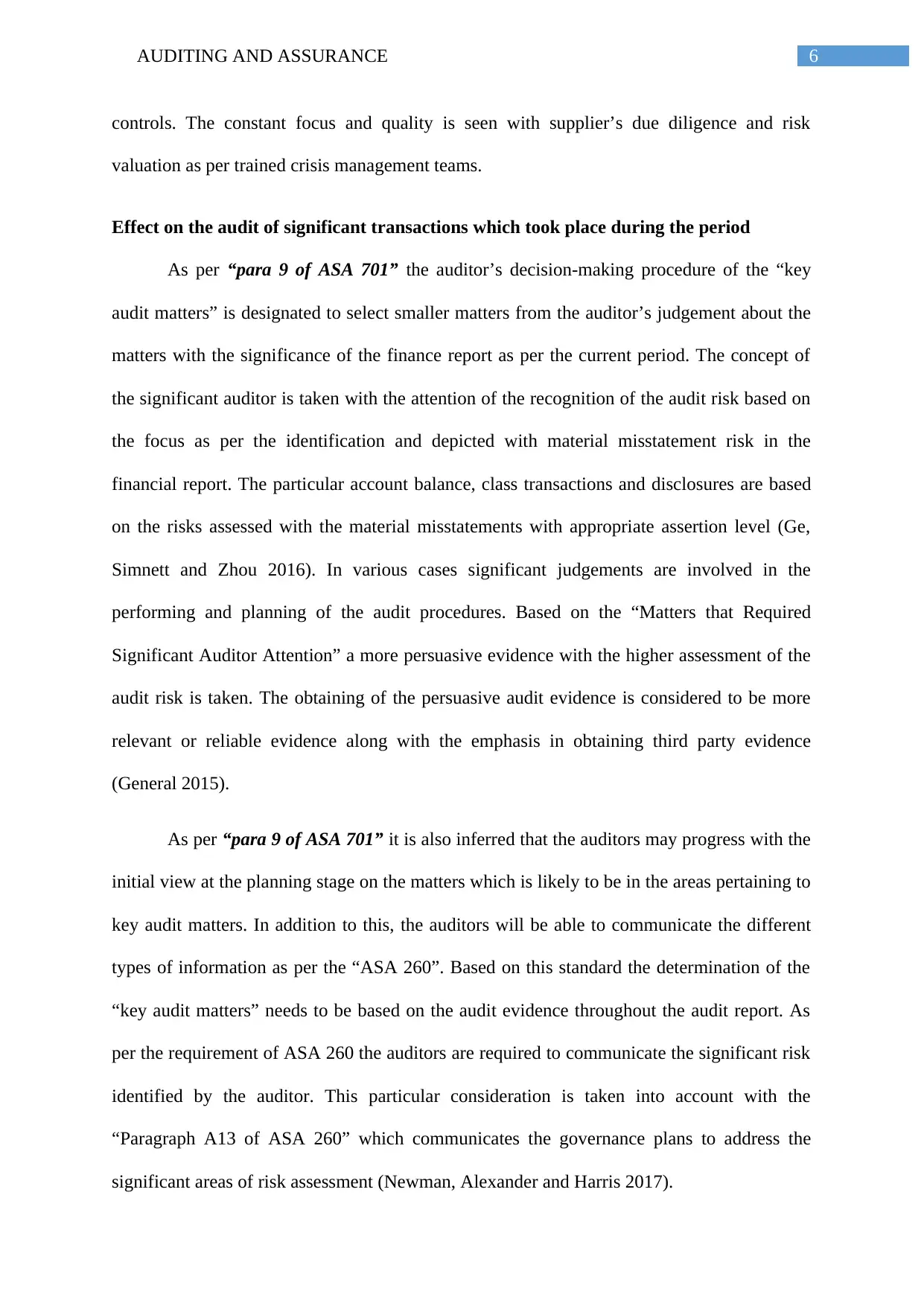
6AUDITING AND ASSURANCE
controls. The constant focus and quality is seen with supplier’s due diligence and risk
valuation as per trained crisis management teams.
Effect on the audit of significant transactions which took place during the period
As per “para 9 of ASA 701” the auditor’s decision-making procedure of the “key
audit matters” is designated to select smaller matters from the auditor’s judgement about the
matters with the significance of the finance report as per the current period. The concept of
the significant auditor is taken with the attention of the recognition of the audit risk based on
the focus as per the identification and depicted with material misstatement risk in the
financial report. The particular account balance, class transactions and disclosures are based
on the risks assessed with the material misstatements with appropriate assertion level (Ge,
Simnett and Zhou 2016). In various cases significant judgements are involved in the
performing and planning of the audit procedures. Based on the “Matters that Required
Significant Auditor Attention” a more persuasive evidence with the higher assessment of the
audit risk is taken. The obtaining of the persuasive audit evidence is considered to be more
relevant or reliable evidence along with the emphasis in obtaining third party evidence
(General 2015).
As per “para 9 of ASA 701” it is also inferred that the auditors may progress with the
initial view at the planning stage on the matters which is likely to be in the areas pertaining to
key audit matters. In addition to this, the auditors will be able to communicate the different
types of information as per the “ASA 260”. Based on this standard the determination of the
“key audit matters” needs to be based on the audit evidence throughout the audit report. As
per the requirement of ASA 260 the auditors are required to communicate the significant risk
identified by the auditor. This particular consideration is taken into account with the
“Paragraph A13 of ASA 260” which communicates the governance plans to address the
significant areas of risk assessment (Newman, Alexander and Harris 2017).
controls. The constant focus and quality is seen with supplier’s due diligence and risk
valuation as per trained crisis management teams.
Effect on the audit of significant transactions which took place during the period
As per “para 9 of ASA 701” the auditor’s decision-making procedure of the “key
audit matters” is designated to select smaller matters from the auditor’s judgement about the
matters with the significance of the finance report as per the current period. The concept of
the significant auditor is taken with the attention of the recognition of the audit risk based on
the focus as per the identification and depicted with material misstatement risk in the
financial report. The particular account balance, class transactions and disclosures are based
on the risks assessed with the material misstatements with appropriate assertion level (Ge,
Simnett and Zhou 2016). In various cases significant judgements are involved in the
performing and planning of the audit procedures. Based on the “Matters that Required
Significant Auditor Attention” a more persuasive evidence with the higher assessment of the
audit risk is taken. The obtaining of the persuasive audit evidence is considered to be more
relevant or reliable evidence along with the emphasis in obtaining third party evidence
(General 2015).
As per “para 9 of ASA 701” it is also inferred that the auditors may progress with the
initial view at the planning stage on the matters which is likely to be in the areas pertaining to
key audit matters. In addition to this, the auditors will be able to communicate the different
types of information as per the “ASA 260”. Based on this standard the determination of the
“key audit matters” needs to be based on the audit evidence throughout the audit report. As
per the requirement of ASA 260 the auditors are required to communicate the significant risk
identified by the auditor. This particular consideration is taken into account with the
“Paragraph A13 of ASA 260” which communicates the governance plans to address the
significant areas of risk assessment (Newman, Alexander and Harris 2017).
Paraphrase This Document
Need a fresh take? Get an instant paraphrase of this document with our AI Paraphraser
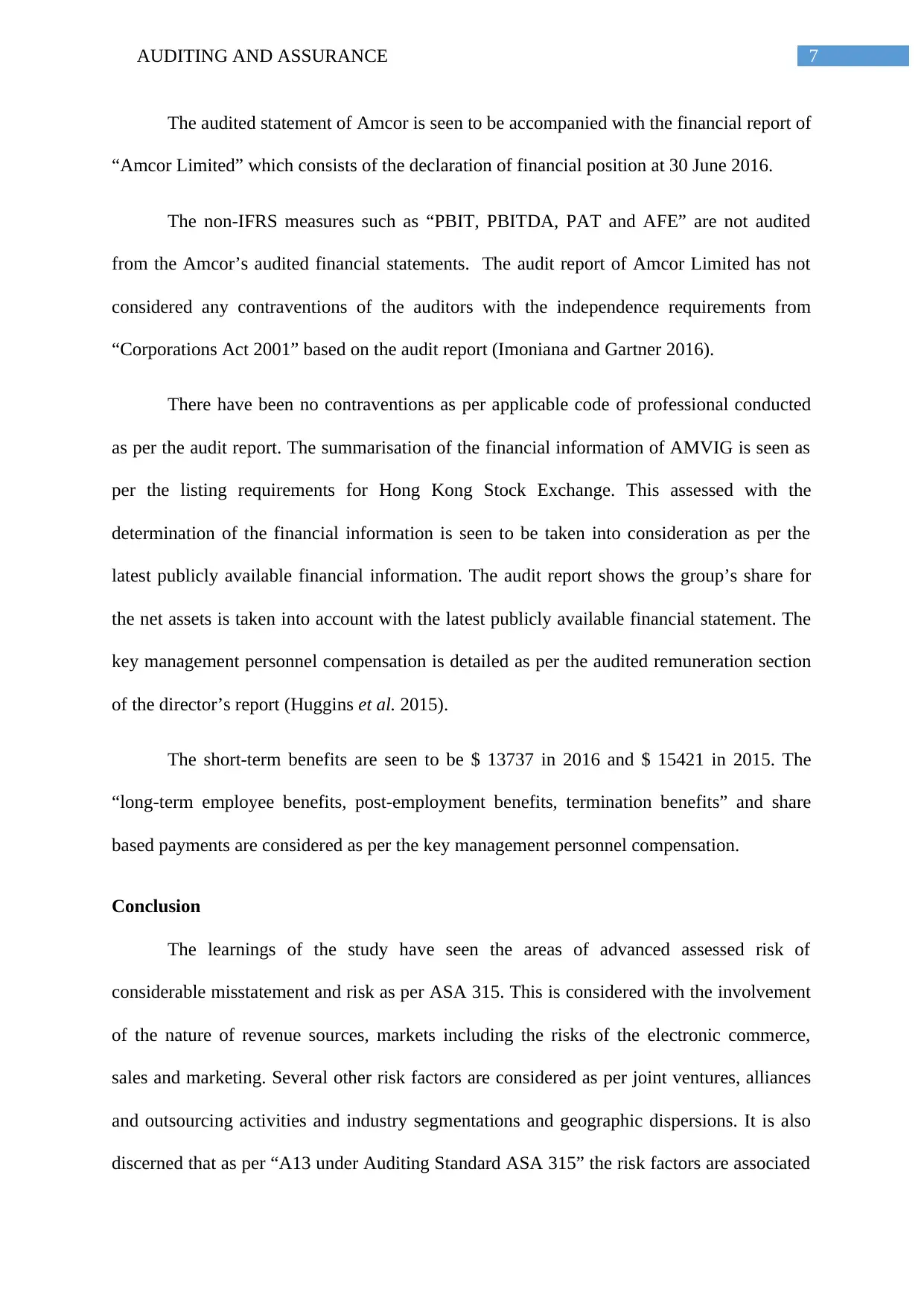
7AUDITING AND ASSURANCE
The audited statement of Amcor is seen to be accompanied with the financial report of
“Amcor Limited” which consists of the declaration of financial position at 30 June 2016.
The non-IFRS measures such as “PBIT, PBITDA, PAT and AFE” are not audited
from the Amcor’s audited financial statements. The audit report of Amcor Limited has not
considered any contraventions of the auditors with the independence requirements from
“Corporations Act 2001” based on the audit report (Imoniana and Gartner 2016).
There have been no contraventions as per applicable code of professional conducted
as per the audit report. The summarisation of the financial information of AMVIG is seen as
per the listing requirements for Hong Kong Stock Exchange. This assessed with the
determination of the financial information is seen to be taken into consideration as per the
latest publicly available financial information. The audit report shows the group’s share for
the net assets is taken into account with the latest publicly available financial statement. The
key management personnel compensation is detailed as per the audited remuneration section
of the director’s report (Huggins et al. 2015).
The short-term benefits are seen to be $ 13737 in 2016 and $ 15421 in 2015. The
“long-term employee benefits, post-employment benefits, termination benefits” and share
based payments are considered as per the key management personnel compensation.
Conclusion
The learnings of the study have seen the areas of advanced assessed risk of
considerable misstatement and risk as per ASA 315. This is considered with the involvement
of the nature of revenue sources, markets including the risks of the electronic commerce,
sales and marketing. Several other risk factors are considered as per joint ventures, alliances
and outsourcing activities and industry segmentations and geographic dispersions. It is also
discerned that as per “A13 under Auditing Standard ASA 315” the risk factors are associated
The audited statement of Amcor is seen to be accompanied with the financial report of
“Amcor Limited” which consists of the declaration of financial position at 30 June 2016.
The non-IFRS measures such as “PBIT, PBITDA, PAT and AFE” are not audited
from the Amcor’s audited financial statements. The audit report of Amcor Limited has not
considered any contraventions of the auditors with the independence requirements from
“Corporations Act 2001” based on the audit report (Imoniana and Gartner 2016).
There have been no contraventions as per applicable code of professional conducted
as per the audit report. The summarisation of the financial information of AMVIG is seen as
per the listing requirements for Hong Kong Stock Exchange. This assessed with the
determination of the financial information is seen to be taken into consideration as per the
latest publicly available financial information. The audit report shows the group’s share for
the net assets is taken into account with the latest publicly available financial statement. The
key management personnel compensation is detailed as per the audited remuneration section
of the director’s report (Huggins et al. 2015).
The short-term benefits are seen to be $ 13737 in 2016 and $ 15421 in 2015. The
“long-term employee benefits, post-employment benefits, termination benefits” and share
based payments are considered as per the key management personnel compensation.
Conclusion
The learnings of the study have seen the areas of advanced assessed risk of
considerable misstatement and risk as per ASA 315. This is considered with the involvement
of the nature of revenue sources, markets including the risks of the electronic commerce,
sales and marketing. Several other risk factors are considered as per joint ventures, alliances
and outsourcing activities and industry segmentations and geographic dispersions. It is also
discerned that as per “A13 under Auditing Standard ASA 315” the risk factors are associated
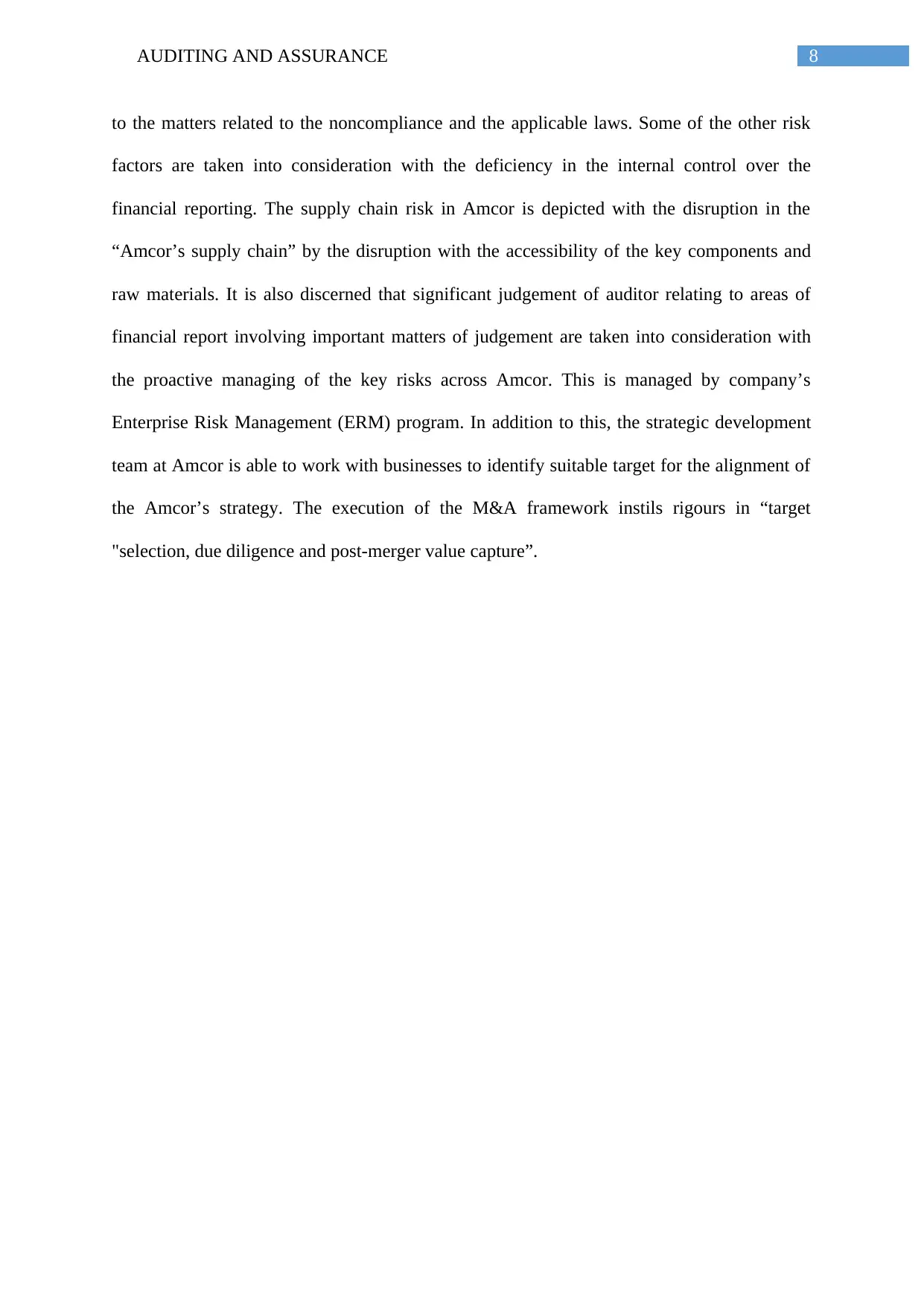
8AUDITING AND ASSURANCE
to the matters related to the noncompliance and the applicable laws. Some of the other risk
factors are taken into consideration with the deficiency in the internal control over the
financial reporting. The supply chain risk in Amcor is depicted with the disruption in the
“Amcor’s supply chain” by the disruption with the accessibility of the key components and
raw materials. It is also discerned that significant judgement of auditor relating to areas of
financial report involving important matters of judgement are taken into consideration with
the proactive managing of the key risks across Amcor. This is managed by company’s
Enterprise Risk Management (ERM) program. In addition to this, the strategic development
team at Amcor is able to work with businesses to identify suitable target for the alignment of
the Amcor’s strategy. The execution of the M&A framework instils rigours in “target
"selection, due diligence and post-merger value capture”.
to the matters related to the noncompliance and the applicable laws. Some of the other risk
factors are taken into consideration with the deficiency in the internal control over the
financial reporting. The supply chain risk in Amcor is depicted with the disruption in the
“Amcor’s supply chain” by the disruption with the accessibility of the key components and
raw materials. It is also discerned that significant judgement of auditor relating to areas of
financial report involving important matters of judgement are taken into consideration with
the proactive managing of the key risks across Amcor. This is managed by company’s
Enterprise Risk Management (ERM) program. In addition to this, the strategic development
team at Amcor is able to work with businesses to identify suitable target for the alignment of
the Amcor’s strategy. The execution of the M&A framework instils rigours in “target
"selection, due diligence and post-merger value capture”.
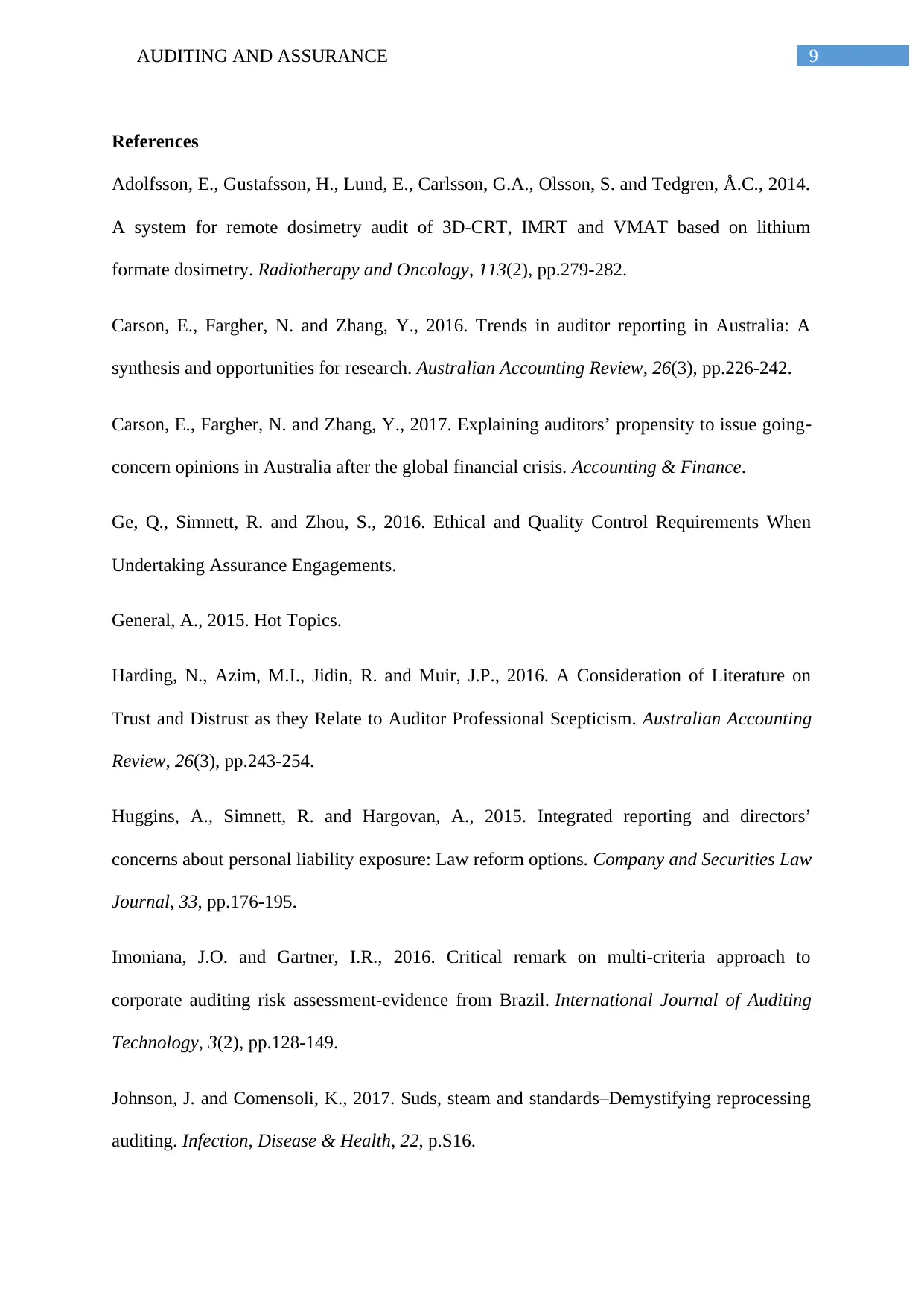
9AUDITING AND ASSURANCE
References
Adolfsson, E., Gustafsson, H., Lund, E., Carlsson, G.A., Olsson, S. and Tedgren, Å.C., 2014.
A system for remote dosimetry audit of 3D-CRT, IMRT and VMAT based on lithium
formate dosimetry. Radiotherapy and Oncology, 113(2), pp.279-282.
Carson, E., Fargher, N. and Zhang, Y., 2016. Trends in auditor reporting in Australia: A
synthesis and opportunities for research. Australian Accounting Review, 26(3), pp.226-242.
Carson, E., Fargher, N. and Zhang, Y., 2017. Explaining auditors’ propensity to issue going‐
concern opinions in Australia after the global financial crisis. Accounting & Finance.
Ge, Q., Simnett, R. and Zhou, S., 2016. Ethical and Quality Control Requirements When
Undertaking Assurance Engagements.
General, A., 2015. Hot Topics.
Harding, N., Azim, M.I., Jidin, R. and Muir, J.P., 2016. A Consideration of Literature on
Trust and Distrust as they Relate to Auditor Professional Scepticism. Australian Accounting
Review, 26(3), pp.243-254.
Huggins, A., Simnett, R. and Hargovan, A., 2015. Integrated reporting and directors’
concerns about personal liability exposure: Law reform options. Company and Securities Law
Journal, 33, pp.176-195.
Imoniana, J.O. and Gartner, I.R., 2016. Critical remark on multi-criteria approach to
corporate auditing risk assessment-evidence from Brazil. International Journal of Auditing
Technology, 3(2), pp.128-149.
Johnson, J. and Comensoli, K., 2017. Suds, steam and standards–Demystifying reprocessing
auditing. Infection, Disease & Health, 22, p.S16.
References
Adolfsson, E., Gustafsson, H., Lund, E., Carlsson, G.A., Olsson, S. and Tedgren, Å.C., 2014.
A system for remote dosimetry audit of 3D-CRT, IMRT and VMAT based on lithium
formate dosimetry. Radiotherapy and Oncology, 113(2), pp.279-282.
Carson, E., Fargher, N. and Zhang, Y., 2016. Trends in auditor reporting in Australia: A
synthesis and opportunities for research. Australian Accounting Review, 26(3), pp.226-242.
Carson, E., Fargher, N. and Zhang, Y., 2017. Explaining auditors’ propensity to issue going‐
concern opinions in Australia after the global financial crisis. Accounting & Finance.
Ge, Q., Simnett, R. and Zhou, S., 2016. Ethical and Quality Control Requirements When
Undertaking Assurance Engagements.
General, A., 2015. Hot Topics.
Harding, N., Azim, M.I., Jidin, R. and Muir, J.P., 2016. A Consideration of Literature on
Trust and Distrust as they Relate to Auditor Professional Scepticism. Australian Accounting
Review, 26(3), pp.243-254.
Huggins, A., Simnett, R. and Hargovan, A., 2015. Integrated reporting and directors’
concerns about personal liability exposure: Law reform options. Company and Securities Law
Journal, 33, pp.176-195.
Imoniana, J.O. and Gartner, I.R., 2016. Critical remark on multi-criteria approach to
corporate auditing risk assessment-evidence from Brazil. International Journal of Auditing
Technology, 3(2), pp.128-149.
Johnson, J. and Comensoli, K., 2017. Suds, steam and standards–Demystifying reprocessing
auditing. Infection, Disease & Health, 22, p.S16.
Secure Best Marks with AI Grader
Need help grading? Try our AI Grader for instant feedback on your assignments.
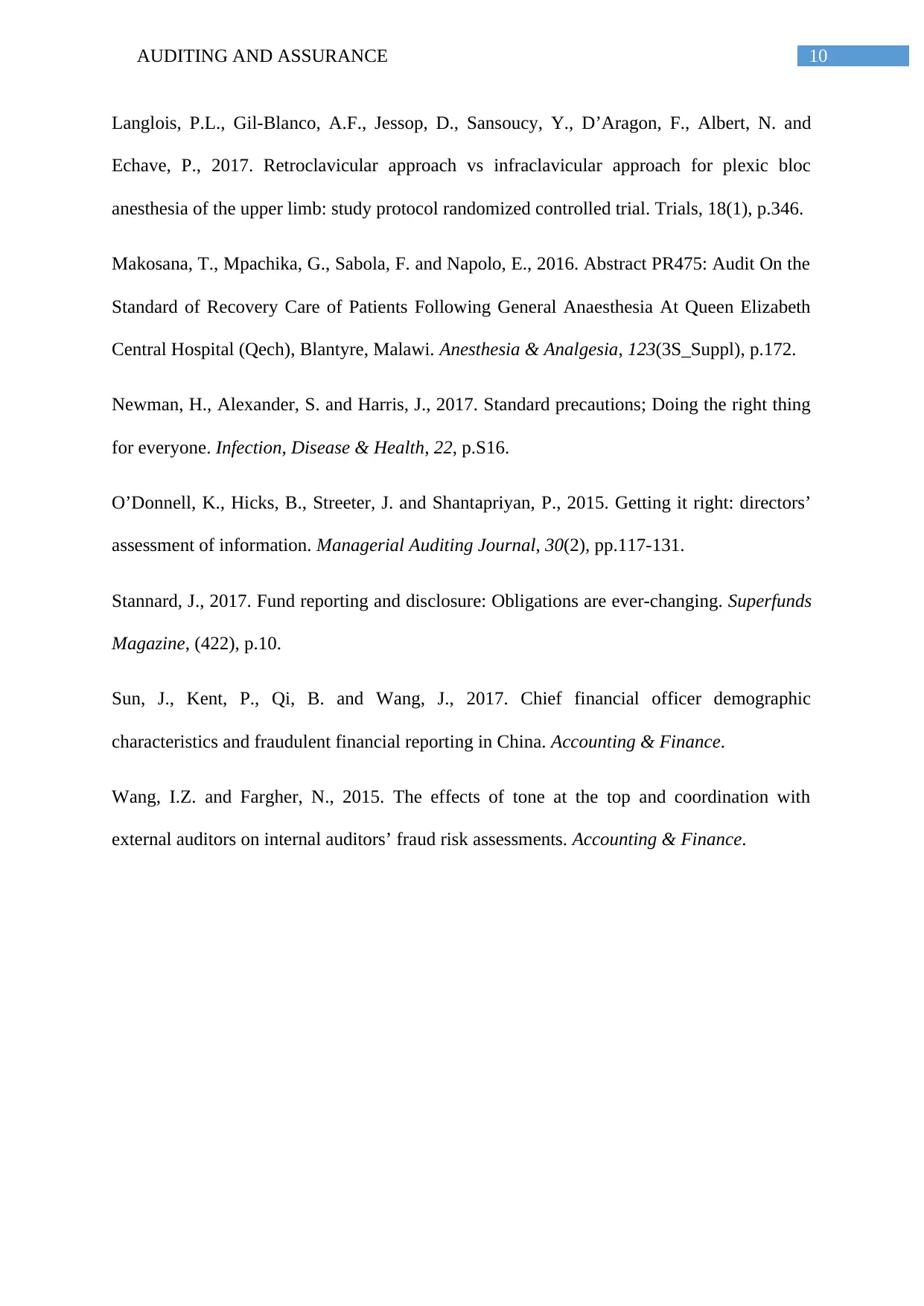
10AUDITING AND ASSURANCE
Langlois, P.L., Gil-Blanco, A.F., Jessop, D., Sansoucy, Y., D’Aragon, F., Albert, N. and
Echave, P., 2017. Retroclavicular approach vs infraclavicular approach for plexic bloc
anesthesia of the upper limb: study protocol randomized controlled trial. Trials, 18(1), p.346.
Makosana, T., Mpachika, G., Sabola, F. and Napolo, E., 2016. Abstract PR475: Audit On the
Standard of Recovery Care of Patients Following General Anaesthesia At Queen Elizabeth
Central Hospital (Qech), Blantyre, Malawi. Anesthesia & Analgesia, 123(3S_Suppl), p.172.
Newman, H., Alexander, S. and Harris, J., 2017. Standard precautions; Doing the right thing
for everyone. Infection, Disease & Health, 22, p.S16.
O’Donnell, K., Hicks, B., Streeter, J. and Shantapriyan, P., 2015. Getting it right: directors’
assessment of information. Managerial Auditing Journal, 30(2), pp.117-131.
Stannard, J., 2017. Fund reporting and disclosure: Obligations are ever-changing. Superfunds
Magazine, (422), p.10.
Sun, J., Kent, P., Qi, B. and Wang, J., 2017. Chief financial officer demographic
characteristics and fraudulent financial reporting in China. Accounting & Finance.
Wang, I.Z. and Fargher, N., 2015. The effects of tone at the top and coordination with
external auditors on internal auditors’ fraud risk assessments. Accounting & Finance.
Langlois, P.L., Gil-Blanco, A.F., Jessop, D., Sansoucy, Y., D’Aragon, F., Albert, N. and
Echave, P., 2017. Retroclavicular approach vs infraclavicular approach for plexic bloc
anesthesia of the upper limb: study protocol randomized controlled trial. Trials, 18(1), p.346.
Makosana, T., Mpachika, G., Sabola, F. and Napolo, E., 2016. Abstract PR475: Audit On the
Standard of Recovery Care of Patients Following General Anaesthesia At Queen Elizabeth
Central Hospital (Qech), Blantyre, Malawi. Anesthesia & Analgesia, 123(3S_Suppl), p.172.
Newman, H., Alexander, S. and Harris, J., 2017. Standard precautions; Doing the right thing
for everyone. Infection, Disease & Health, 22, p.S16.
O’Donnell, K., Hicks, B., Streeter, J. and Shantapriyan, P., 2015. Getting it right: directors’
assessment of information. Managerial Auditing Journal, 30(2), pp.117-131.
Stannard, J., 2017. Fund reporting and disclosure: Obligations are ever-changing. Superfunds
Magazine, (422), p.10.
Sun, J., Kent, P., Qi, B. and Wang, J., 2017. Chief financial officer demographic
characteristics and fraudulent financial reporting in China. Accounting & Finance.
Wang, I.Z. and Fargher, N., 2015. The effects of tone at the top and coordination with
external auditors on internal auditors’ fraud risk assessments. Accounting & Finance.
1 out of 11
Related Documents
Your All-in-One AI-Powered Toolkit for Academic Success.
+13062052269
info@desklib.com
Available 24*7 on WhatsApp / Email
![[object Object]](/_next/static/media/star-bottom.7253800d.svg)
Unlock your academic potential
© 2024 | Zucol Services PVT LTD | All rights reserved.





